As a lifelong bird enthusiast and pigeon keeper, I’ve always found doves to be some of the most fascinating birds in Arizona. Their gentle demeanor, soothing calls, and wide range of appearances make them a joy to observe whether in the wild or in your own backyard.
Living in Arizona has given me the chance to witness many species up close—from the familiar Mourning Dove to the rarer visitors like the White-tipped Dove. Each one has its own habits, calls, and beauty that deserve appreciation and understanding.
In this guide, I’ll walk you through 9 types of doves you can find across Arizona, complete with identification tips, photos, and fun facts from my own birding experience. Whether you’re a casual observer or a devoted dove lover like me, this list will deepen your connection with these remarkable birds.
Common Doves Found in Arizona
Mourning Dove (Zenaida macroura)
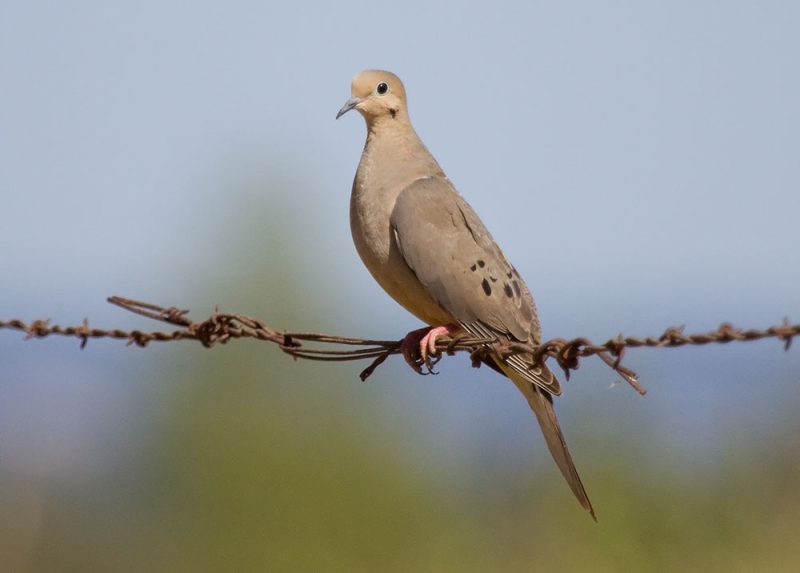
The Mourning Dove is one of the most commonly seen doves in Arizona, known for its soft gray-brown plumage and long, pointed tail with white edges. Adults have small heads, slender bodies, and black spots on their wings. Their overall appearance is sleek and delicate, with a subtle iridescence on the neck visible in good light. Males and females look similar, though males tend to be slightly larger and more colorful.
This species produces a mournful cooing sound, often interpreted as sad or haunting, which gives it its name. Mourning Doves are strong, fast fliers, and they take off with a sharp whistling of their wings. Their behavior is generally peaceful, and they can be seen in pairs or small flocks, often perched on power lines, fences, or foraging on the ground. They build flimsy nests in trees or shrubs and lay two eggs, sometimes raising several broods in one season.
Mourning Doves primarily eat seeds from grasses, weeds, and cultivated crops like millet and sunflower. They forage mainly on the ground, often in open fields, desert scrub, or suburban lawns. Their diet is supplemented with small amounts of grit to aid digestion. They are highly adaptable and can thrive in urban, agricultural, and rural environments.
In Arizona, Mourning Doves are widespread and can be found year-round throughout the state, from deserts and agricultural lands to city parks. A fun fact: despite being one of the most hunted game birds in North America, Mourning Doves maintain strong populations due to their prolific breeding capabilities—some pairs may raise up to six broods per year.
White-winged Dove (Zenaida asiatica)
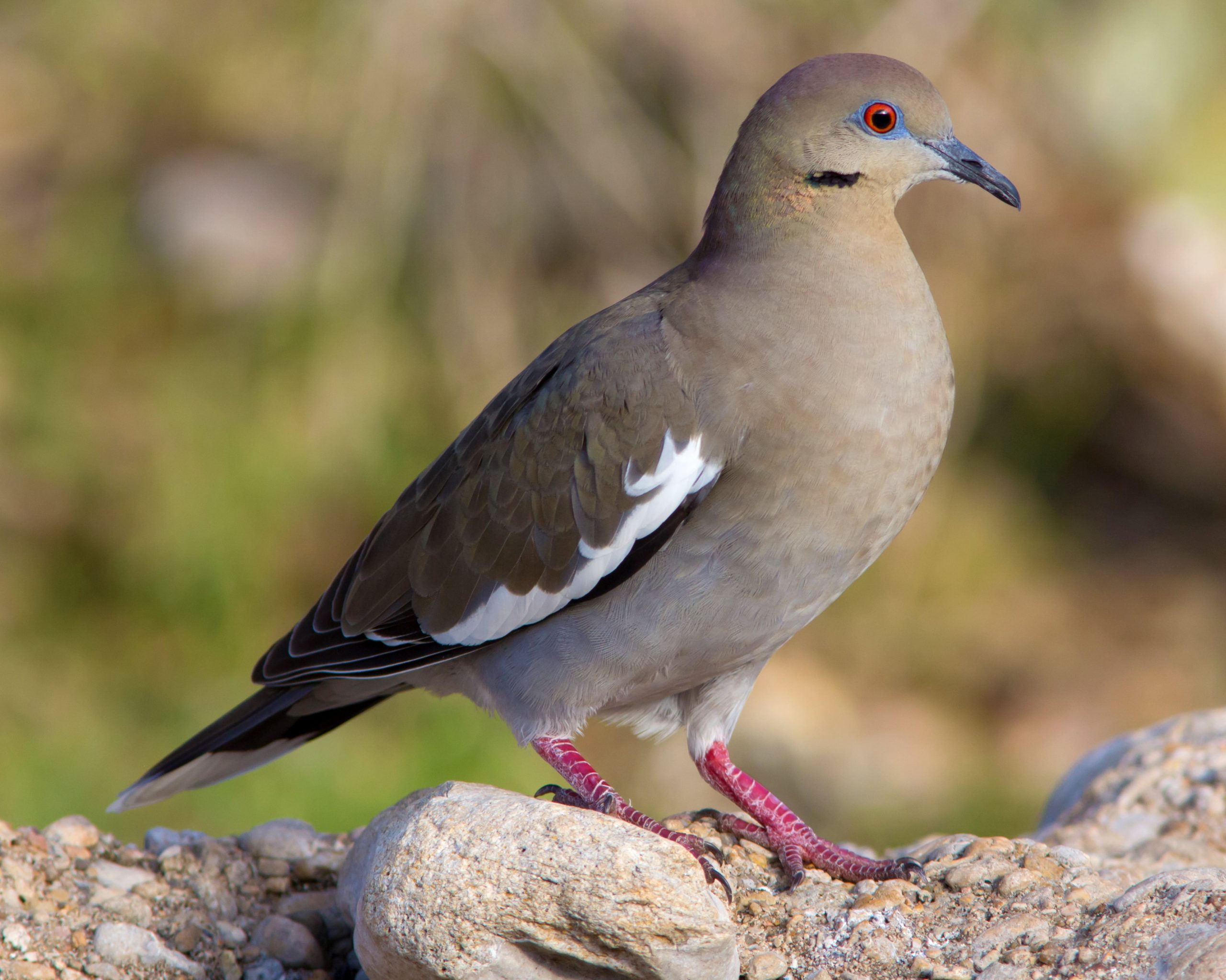
White-winged Doves are medium-sized doves with a distinct white edge on their wings, visible both in flight and at rest. Their plumage is light brown with a slightly paler belly, and they have a bold white stripe on each wing and a dark line on the cheek. The eye ring is bright blue, and their legs are pinkish-red. These doves are larger and stockier than Mourning Doves, with a square tail tipped in white.
Their call is a rhythmic “who-cooks-for-you,” which can carry quite far and is commonly heard during early morning and evening hours in summer. White-winged Doves are social and often gather in large flocks near food or water sources. They are highly migratory, arriving in Arizona during spring and summer to breed. Nests are placed in trees, cacti, or shrubs, and they often nest in colonies, laying two white eggs per clutch.
White-winged Doves primarily feed on seeds, grains, and fruits. They are particularly fond of saguaro cactus fruit, which is abundant in southern Arizona during their breeding season. They often visit backyard feeders stocked with millet, cracked corn, or sunflower seeds. These birds are commonly seen near agricultural fields, suburban gardens, and Sonoran Desert landscapes.
In Arizona, they are especially abundant in the southern half of the state, including Tucson and surrounding desert areas, during spring and summer. A fun fact: these doves play an important ecological role in the Sonoran Desert by dispersing seeds of native plants, particularly saguaro cacti, through their droppings.
Eurasian Collared-Dove (Streptopelia decaocto)
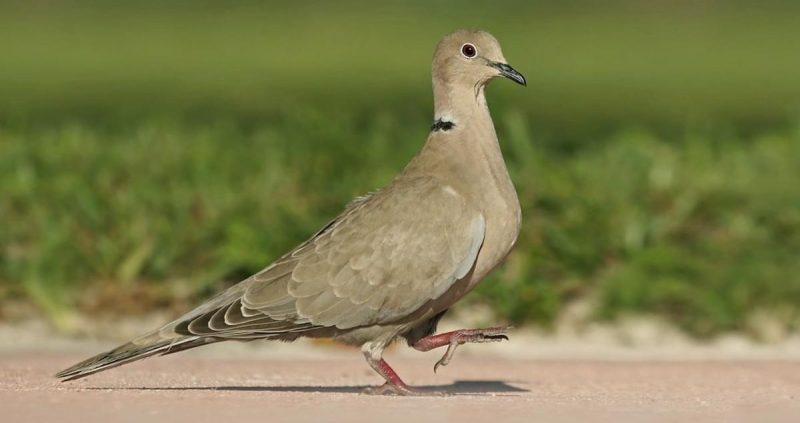
The Eurasian Collared-Dove is a non-native species that has quickly expanded its range across North America. It is easily recognized by its pale gray body, black crescent-shaped collar around the back of the neck, and squared-off tail with broad white tips. It is larger than Mourning Doves and slightly bulkier, with a more upright posture when perched.
Their call is a distinct three-part “coo-COO-coo,” repeated throughout the day and often mistaken for other dove species. Eurasian Collared-Doves are known for their adaptability and tend to stay close to human habitation. They are not shy around people and often forage in parking lots, near grain silos, or in residential neighborhoods. They breed year-round in warm climates, building loose twig nests in trees or even on man-made structures.
Their diet consists mainly of seeds and grains, but they will also eat berries and food scraps. They are commonly seen feeding on the ground in open areas or visiting backyard feeders. Unlike some other doves, they tend to be more aggressive and may displace native species from feeding areas or nesting sites.
In Arizona, Eurasian Collared-Doves can be found statewide and are present year-round, especially in urban and agricultural regions. Fun fact: this species was introduced to the Bahamas in the 1970s and made its way to Florida by the 1980s—today, it can be found across most of the U.S., including rural and desert parts of Arizona.
Rock Pigeon (Columba livia)

Rock Pigeons, commonly known as city pigeons, are one of the most familiar birds around the world. They come in various color morphs, but the classic form features a blue-gray body, iridescent green and purple neck, and two black bars on each wing. Their eyes are orange or red, and they have stout bodies with short legs and small heads. These birds are robust and adaptable, often forming large flocks.
Their cooing is soft and continuous, often heard in city parks or building ledges. Rock Pigeons are highly social and will gather in flocks to feed, roost, or nest. They build simple nests on building ledges, bridges, or other structures, often raising multiple broods each year. Their behavior is largely shaped by their close association with humans and urban environments.
They eat seeds, grains, and a variety of food scraps, thriving in cities where food is abundant. They forage on sidewalks, around dumpsters, or in open fields. Rock Pigeons have even adapted to rural farmlands and desert towns in Arizona, especially where grain or water is available.
In Arizona, Rock Pigeons are widespread and can be found in nearly every town or city, including Phoenix and Tucson. Fun fact: these birds were domesticated thousands of years ago and used as message carriers—some even served in both World Wars, with medals awarded for their service.
Inca Dove (Columbina inca)
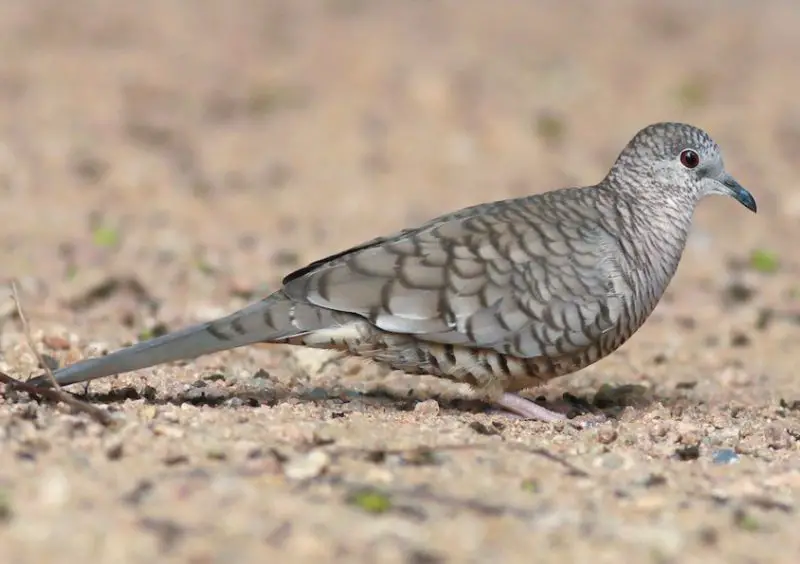
The Inca Dove is a small, slender dove with light brown to gray feathers that have a scaly appearance due to dark feather edges. It has a long, squared tail with white edges and reddish inner wings visible during flight. This unique scaly pattern makes it easy to distinguish from other doves. Its delicate size and quiet demeanor also make it stand out among Arizona’s dove species.
Its call is a gentle “coo-coo-coo,” often repeated in soft, almost whisper-like tones. Inca Doves are known for their social nature, sometimes roosting in tight groups in colder weather to conserve heat. They are relatively tame and often frequent backyards, patios, and urban gardens, where they can be seen feeding on the ground. Their nests are fragile-looking platforms made of twigs and placed in shrubs or trees.
Inca Doves feed primarily on small seeds, especially grass seeds and millet. They are frequent visitors at ground feeders in residential areas and enjoy open spaces with some low cover. These birds prefer warmer climates and do not migrate, remaining year-round in areas where temperatures stay mild.
In Arizona, they are most common in the southern part of the state, including cities like Tucson and Yuma. Fun fact: Inca Doves sometimes sunbathe by spreading their wings flat against the ground, appearing like they’re melting in the sun—a behavior that helps them regulate body temperature.
Common Ground Dove (Columbina passerina)
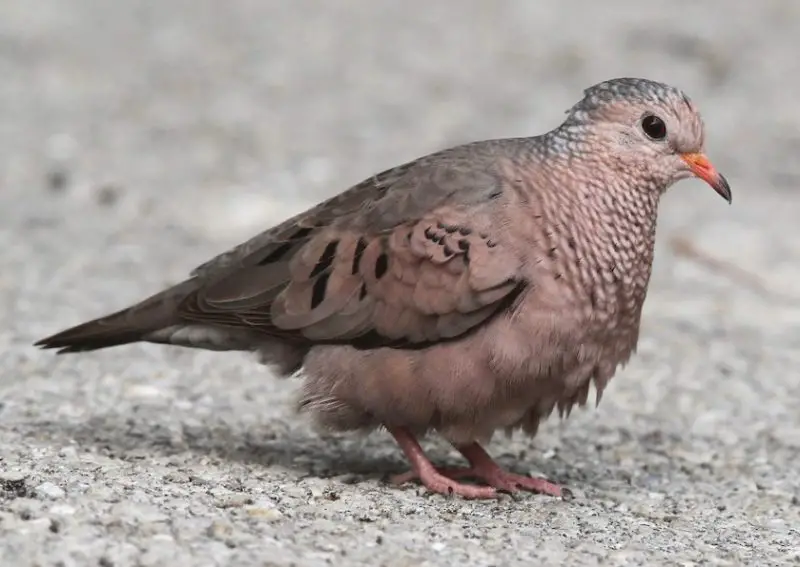
The Common Ground Dove is the smallest dove species in the United States, measuring only about 6.5 inches in length. It has a compact, chunky body with a short tail and a scaled appearance on its head and chest. Its plumage is generally grayish-brown, but males show a pinkish wash on the chest and reddish wing patches in flight. The bill is short with a noticeable yellow base and black tip.
This dove produces a repetitive, high-pitched cooing call that sounds like “woot-woot-woot,” often rising in pitch. They are secretive and prefer to walk away quietly rather than fly when disturbed. Common Ground Doves nest close to the ground, often in low shrubs, using twigs and grasses to build simple nests. Females typically lay two white eggs, and both parents take turns incubating.
Their diet consists mainly of small seeds, including those of grasses and weeds. They forage on the ground, usually alone or in pairs, rarely forming flocks like other dove species. Their low, fluttering flight pattern and quiet demeanor help them stay concealed in their preferred dry and grassy habitats.
In Arizona, Common Ground Doves are more frequently found in the southern and southwestern parts of the state, including areas like Tucson, Yuma, and the Sonoran Desert. Fun fact: these doves are so small that they are often mistaken for sparrows when seen from a distance or while foraging on the ground.
Band-tailed Pigeon (Patagioenas fasciata)

The Band-tailed Pigeon is the largest pigeon species in North America, measuring up to 16 inches long. It resembles the Rock Pigeon but has a more uniform gray body, a distinctive white band at the nape of the neck, and a broad pale gray band on the tail. Its legs and feet are yellow, and the eye ring is a noticeable yellow as well, adding to its striking appearance.
This species produces a low, owl-like “whooo-uh” call that is often heard in forested mountain areas. Band-tailed Pigeons are generally shy and wary, often flying away at the slightest disturbance. They nest in trees and build stick platforms, usually in pine or oak forests. Their breeding season coincides with the availability of acorns and other natural food sources in higher elevation forests.
Their diet is primarily vegetarian, consisting of acorns, berries, seeds, and fruits. They are especially fond of elderberries, madrone berries, and manzanita. Unlike urban pigeons, Band-tailed Pigeons rarely visit feeders and are more likely to be found in natural woodland settings.
In Arizona, they are mostly found in mountainous areas during the breeding season, such as the Mogollon Rim, the White Mountains, and the Sky Islands of southeastern Arizona. Fun fact: the Band-tailed Pigeon is considered the closest living relative of the now-extinct Passenger Pigeon, sharing several physical and behavioral traits.
Ruddy Ground-Dove (Columbina talpacoti)
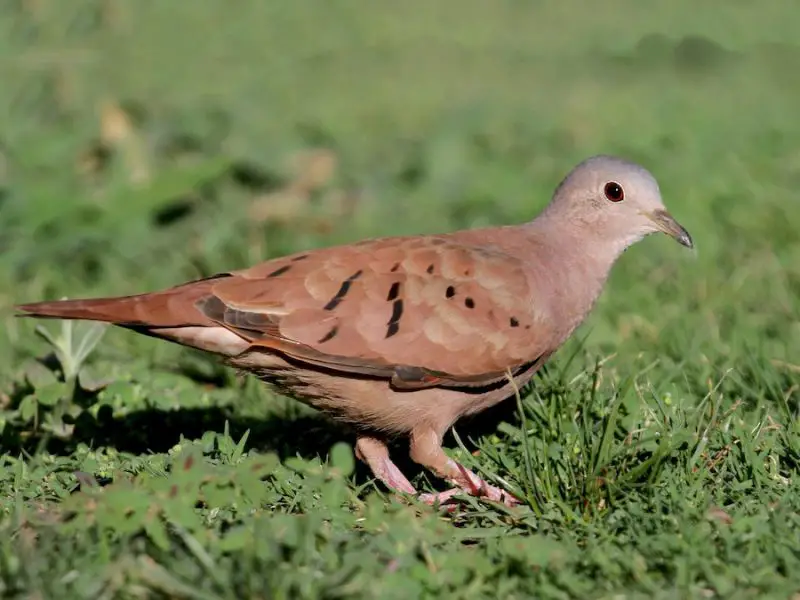
The Ruddy Ground-Dove is a small dove species with rich reddish-brown plumage, particularly vibrant in males. Females are duller with more brownish-gray tones and lack the deep rufous coloration of the males. Both sexes have short tails, a straight profile, and dark spots on the wings. They are about the same size as the Common Ground Dove, measuring around 6.5 to 7 inches.
Their vocalizations consist of soft, repeated “coo-coo-coo” notes, often heard in tropical and subtropical regions. Ruddy Ground-Doves tend to be shy and unobtrusive, foraging on the ground for seeds and grains. They are often found in open areas, farmland, or near brushy fields. Nesting usually occurs in low trees or shrubs, and they often build nests just a few feet off the ground.
These doves feed primarily on grass and weed seeds and are typically seen walking on the ground rather than perching in trees. They prefer warm climates and are more commonly found in Central and South America, though some individuals wander into the southwestern U.S.
In Arizona, Ruddy Ground-Doves are considered rare and are mostly seen in the southernmost parts of the state near the Mexico border, such as around Nogales and the Santa Cruz Valley. Fun fact: this species is often a target for birders visiting Arizona in hopes of spotting rare or tropical vagrant species.
White-tipped Dove (Leptotila verreauxi)

The White-tipped Dove is a robust and secretive dove with a plain grayish-brown body, a pale forehead, and white tips on the tail feathers that are visible in flight. It also has a subtle iridescent patch on the neck, and its legs are pinkish-red. It is larger than the Inca and Common Ground Doves, averaging around 11 inches in length.
Its call is a deep, resonant “whooooo,” somewhat reminiscent of an owl and often echoing through dense forest understory. White-tipped Doves are shy and prefer thick brush, forests, or riparian areas. They usually walk slowly on the ground in search of seeds and fruits. Nesting typically occurs in dense vegetation, where they build stick nests and lay two white eggs.
Their diet includes seeds, berries, and small fruits, and they are known to consume insects occasionally. They forage mostly on the ground and are rarely seen in open areas. Due to their preference for thick cover, they can be difficult to spot despite their size.
In Arizona, the White-tipped Dove is extremely rare and has only been recorded a handful of times, most recently in Hereford in 2022. It is generally considered a vagrant from Mexico. Fun fact: White-tipped Doves are more commonly found in Central America and are one of the few dove species that thrive in dense forest habitats rather than open country.
FAQs about Doves in Arizona
What are the most common types of doves found in Arizona?
The most common doves in Arizona include the Mourning Dove, White-winged Dove, Eurasian Collared-Dove, Rock Pigeon, and Inca Dove. These species are frequently seen across various habitats in the state.
How can I identify a Mourning Dove?
Mourning Doves have a slender body with soft gray-brown feathers, black spots on their wings, and a long, pointed tail with white edges. They produce a soft, mournful cooing sound that is quite distinctive.
Are any dove species in Arizona considered rare or endangered?
Yes, species like the White-tipped Dove are extremely rare in Arizona and are considered vagrants from Mexico. Most other dove species are common and not endangered in the state.
What do doves in Arizona eat?
Doves primarily feed on seeds, grains, and small fruits. Some species, like the White-winged Dove, also enjoy native fruits such as saguaro cactus fruit.
Where can I find doves in Arizona?
Doves are highly adaptable and can be found in deserts, woodlands, urban areas, and agricultural lands throughout Arizona. Certain species, like the Band-tailed Pigeon, prefer mountainous forested regions.
Do doves migrate in Arizona?
Some species, such as the White-winged Dove, are migratory and arrive in Arizona during spring and summer to breed. Others, like the Mourning Dove and Eurasian Collared-Dove, are year-round residents.
Can I attract doves to my backyard in Arizona?
Yes, providing food such as millet, cracked corn, or sunflower seeds, along with water sources, can attract many dove species to your backyard. Planting native shrubs can also offer shelter and nesting sites.
Are doves noisy birds?
Doves produce a variety of cooing calls that range from soft and mournful to rhythmic and repetitive. Their calls are often soothing and a common sound in Arizona’s natural landscapes.
How do doves breed in Arizona?
Most doves build simple twig nests in trees or shrubs and lay two white eggs per clutch. Some species may have multiple broods per year, especially in warmer climates like Arizona.






